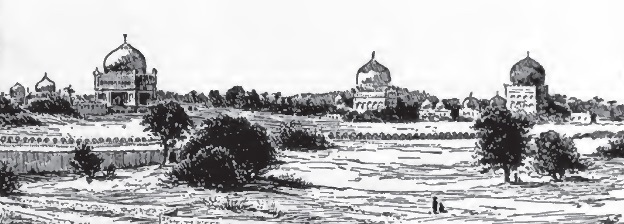

The Medieval Period of Indian history, though it does not exactly correspond with the Middle Age of Europe, is not less clearly defined. It begins when the immemorial systems, rule, and customs of Ancient India were invaded, subdued, and modified by a succession of foreign conquerors who imposed a new rule and introduced an exotic creed, strange languages, and a foreign art. These conquerors were Moslems, and with the arrival of the Turks under Mahmud of Ghazni at the beginning of the eleventh century, India entered upon her Middle Age. From that epoch for nearly eight hundred years her history is grouped round the Mohammedan rulers who gradually brought under their control nearly the whole country from the Himalayas to the Krishna River. The period ends when one of the last of these rulers, oppressed by the revival of Hindu ascendency, placed himself under English protection, and Modern India came into being.
Distinct and clearly marked as the Medieval or Mohammedan Period is, the transition implies no violent change. History is always continuous; there can
be no “fresh start”; and each new period carries on much of what preceded it. In India, as ever in the East, change is so gradual as to be almost imperceptible. Ancient India was too deeply rooted in its traditions to wither even under the storm of Moslem conquest. The old Indian life survived the shock of the new ideas, which it modified at least as much as it was modified; it outlived the Moslem Period, and still endures, but little altered, in the modern age of English domination. It never really assimilated the foreigners or their ideas. Despite the efforts of a few wide-seeing men like Akbar, no true or permanent union, except occasionally among the official and ruling classes, ever took place between the Moslems and the Hindus; and the ascendant races, whether Turks, Persians, Afghans, or Moghuls, remained essentially an army of occupation among a hostile or at least repellent population.
The history of the Mohammedan Period is, therefore, necessarily more a chronicle of kings and courts and conquests than of organic or national growth. The vast mass of the people enjoy the doubtful happiness of having no history, since they show no development; apparently they are the same yesterday, to-day, and forever. Nor was there any such marked change even in the principles and methods of government as might be expected from the diversity of successive rulers of various races. English Collector-Magistrates follow much the same system, in essential outline, as that which Akbar adopted from his Hindu Chancellor, and many executive details and most of the principles of
local administration have their origin in probably prehistoric custom. But in the character and life of the rulers there is infinite variety, and it is round the lives of great men – and a few great women, though such seldom emerge before the public gaze in the East – that the chief interest of the Medieval Period centres. A history of the people is usually assumed, in the present day, to be more stimulating and instructive than the record of kings and courts; but even if true, this can only be understood of Western peoples, of peoples who strive to go forward, or at least change. In the East the people does not change, and there, far more than among progressive races, the “simple annals of the poor,” however moving and pathetic, are indescribably trite and monotonous compared with the lives of those more fortunate beings to whom much has been given in opportunity, wealth, power, and knowledge. Such contrasted characters as those of Ala-ad-din, Mohammad Taghlak, Babar, Akbar, and Aurangzib may rival any that could be named in Europe in the same four centuries; and in the lives and policies, the wars and studies, the habits and ceremonies of such leaders the imagination finds ample scope for the realization of strangely vivid and dramatic situations.
This collection transcribed by Chris Gage![]()
